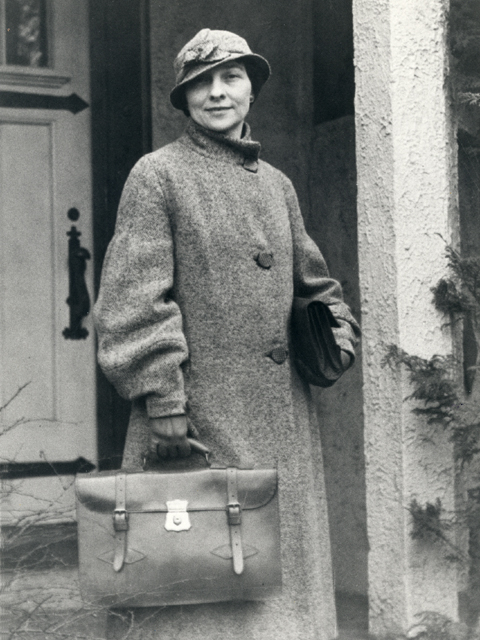America’s greatest codebreaker was a Coast Guard civilian. Elizebeth Smith Friedman taught herself code breaking, and changed the 20th century. But her contributions only came to light recently, when secret government files were unsealed.
Now, a new PBS film offers a personal look at this suburban mom who lived a double-life as a code breaker who hunted Nazi spies. (Find your local showtimes here.)
The Codebreaker reveals the fascinating story of Friedman, the groundbreaking cryptanalyst whose painstaking work to decode thousands of messages for the U.S. government would send infamous gangsters to prison in the 1930s and bring down a massive, near-invisible Nazi spy ring in WWII.
The film is based on the book The Woman Who Smashed Codes: A True Story of Love, Spies, and the Unlikely Heroine Who Outwitted America's Enemies, by Jason Fargone,
Together with her husband, the legendary cryptologist William Friedman, Elizebeth helped develop the methods that led to the creation of the powerful new science of cryptology and laid the foundation for modern codebreaking today.
Friedman’s remarkable legacy
Friedman was a pioneering code-breaker for the Coast Guard during the Prohibition Era and World War II, serving as a civilian within the Coast Guard Cryptanalytic Unit-387.
She has been dubbed "America's first female cryptanalyst" and in many ways could be considered a founder of the modern-day Coast Guard Intelligence Program. Her work with the Coast Guard began soon after the passage of the Volstead Act, which prohibited the manufacture, sale, or trade of alcohol in the United States. Liquor smugglers frequently made use of radios to coordinate their activities and began to encode their messages.
Friedman was detailed from the Treasury Department to the Coast Guard, thus beginning a remarkable career. Between 1927 and 1930, she is estimated to have solved over 12,000 smuggling messages in hundreds of different code systems, all by hand with just pencil and paper.
“I became interested in her after reading Fargone's book,” said CDR Charles Keller (Ret.). His article, “Unsung Hero,” in the U.S. Coast Guard Academy Alumni Association Bulletin includes rare photos plus stories of her work uncovering rum smuggling and other illegal conspiracies.
“Hoover had all her work classified so he could take the credit. And when the USCG was transferred to the U.S. Navy they did not allow a civilian to supervise officers, so a USCG officer under her was placed in command.”
But Friedman was undaunted, even as others took credit for her work. Even after Friedman resigned to raise her second child, she continued – without pay – to informally help the Coast Guard break codes.
Keller is in touch with Friedman’s surviving relatives, continuing to learn more about her unsung role.
The National Security Agency named a building after Friedman and her husband. The Bureau of Alcohol, Tobacco, Firearms and Explosives headquarters has an auditorium dedicated to her.
In June, the Coast Guard announced it was naming its 11th Legend-Class National Security Cutter (NSC) in her honor.
Keller is trying to get the U.S. Coast Guard Academy to name its Crypto Lab after Friedman. “There is so much mounting evidence,” he said, “that this woman was a very special person.”
Friedman’s codebreaking career started with Shakespeare
Friedman’s code work began in 19916 when she went to work for the eccentric millionaire Colonel George Faybyan in Illinois. His firm, Riverbank Laboratories, hired Friedman to help decode a cipher that proved Francis Bacon wrote Shakespeare’s works. There she met and married William Friedman, who asked her to teach him code breaking. (He also went on to have a famous career as a codebreaker for the U.S. Navy, making twice the salary as his wife and taking on assignments the military deemed "too dangerous" for a woman.)
She resigned from Riverbank when she gave birth to her daughter – that lasted until the Coast Guard’s intelligence officer, Captain Charles Root, visited with an offer she couldn’t refuse.
Liquor smugglers were using coded messages and the Coast Guard needed help in decoding them. The crime catching agencies of the Treasury Department were overflowing with odds and ends of mysterious messages, but they had no means of deciphering them.
Freidman was appointed a “special agent” to be paid by the Department of Justice, on loan to Captain Root. A special agent in those days was someone who did not have to conform to the requirements of office. For this reason, she was able to work at home. She would go to Captain’s Root’s office, collect necessary coded messages―at the beginning there was a large backlog of messages―take them home and when solved, return them.
Her work led to 650 federal prosecutions and she personally testified in 33 cases. During World War II, she was part of the team that broke the codes generated by the formidable Enigma-machine used by the Germans. She played a key role in exposing a ring of German spies in South America, effectively denying them a foothold in the Western Hemisphere during the war.
Her Cryptanalytic Unit eventually moved from Treasury and evolved into the modern Coast Guard Intelligence program. Only recently was her legacy fully appreciated when a journalist researched now-declassified papers and discovered her pivotal role in the Enigma-machine code-breaking as well as the Customs Prohibition operations.
Resources